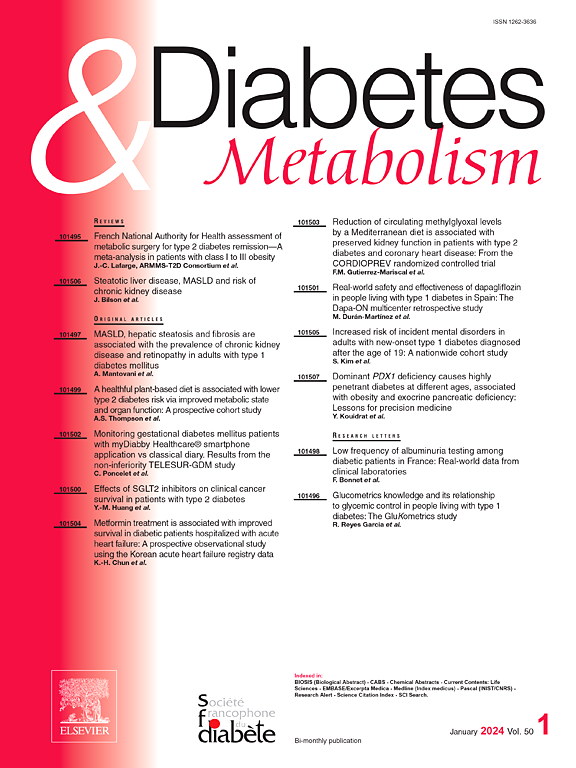GLP-1-derived therapies and sarcopenia: plea for a specific focus on at risk special populations
IF 4.7
2区 医学
Q1 ENDOCRINOLOGY & METABOLISM
引用次数: 0
Abstract
Background
A risk of excessive reduction in skeletal muscle mass (SSM), potentially leading to sarcopenia, when using glucagon-like peptide-1 (GLP-1)-based therapies, is currently a matter of debate. While most available results are rather reassuring in the general population, sarcopenia may become a concern in some special subgroups with comorbidities known to be associated with a higher risk of sarcopenia, independently of any GLP-1-based therapy.
Methods
An extensive literature search was done to identify studies that investigated the effects of GLP-1-based therapies on changes in SMM and sarcopenia in special populations, i.e. older people, patients with type 2 diabetes, atherosclerotic cardiovascular disease, heart failure, chronic kidney disease, and metabolic dysfunction–associated liver disease.
Results
Several publications emphasized the risk of sarcopenia and recommended caution when prescribing GLP-1-based therapies in people with these comorbidities of interest. However, hard data remain scarce in the literature, without any evidence-based demonstration of a significantly increased risk of sarcopenia. Nevertheless, as old age potentiates the risk of sarcopenia, older patients with these comorbidities (especially advanced heart failure or renal disease) deserve more careful attention.
Conclusion
While the risk of sarcopenia associated with GLP-1-based therapies remains controversial in the general population, a higher risk in special populations with comorbidities has been repeatedly emphasized despite the lack of evidence-based data in the literature. Because these agents showed major clinical benefits in patients with such comorbidities but sarcopenia could mitigate them, there is an urgent need to implement dedicated studies with appropriate measures of sarcopenia in these special populations.
glp -1衍生疗法和肌肉减少症:请求特别关注高危特殊人群。
背景:当使用胰高血糖素样肽-1 (GLP-1)为基础的治疗时,骨骼肌质量(SSM)过度减少的风险,可能导致肌肉减少症,目前是一个有争议的问题。虽然大多数可用的结果在一般人群中相当令人放心,但肌少症可能会成为一些特殊亚组的担忧,这些亚组的合并症已知与肌少症的高风险相关,独立于任何基于glp -1的治疗。方法:进行了广泛的文献检索,以确定研究glp -1为基础的治疗对特殊人群(如老年人、2型糖尿病患者、动脉粥样硬化性心血管疾病、心力衰竭、慢性肾脏疾病和代谢功能障碍相关肝病)中SMM和肌肉减少症变化的影响。结果:一些出版物强调了肌肉减少症的风险,并建议在患有这些合并症的患者中使用基于glp -1的治疗时要谨慎。然而,文献中缺乏硬数据,没有任何基于证据的证据表明肌肉减少症的风险显着增加。然而,由于老年增加了肌肉减少症的风险,有这些合并症(尤其是晚期心力衰竭或肾脏疾病)的老年患者应该得到更多的注意。结论:尽管在一般人群中,基于glp -1的治疗与肌肉减少症相关的风险仍存在争议,但在具有合并症的特殊人群中,尽管缺乏文献中基于证据的数据,但风险更高已被反复强调。由于这些药物在患有这些合并症的患者中显示出主要的临床益处,但肌肉减少症可以减轻这些合并症,因此迫切需要在这些特殊人群中实施针对肌肉减少症的适当措施的专门研究。
本文章由计算机程序翻译,如有差异,请以英文原文为准。
求助全文
约1分钟内获得全文
求助全文
来源期刊

Diabetes & metabolism
医学-内分泌学与代谢
CiteScore
12.00
自引率
4.20%
发文量
86
审稿时长
13 days
期刊介绍:
A high quality scientific journal with an international readership
Official publication of the SFD, Diabetes & Metabolism, publishes high-quality papers by leading teams, forming a close link between hospital and research units. Diabetes & Metabolism is published in English language and is indexed in all major databases with its impact factor constantly progressing.
Diabetes & Metabolism contains original articles, short reports and comprehensive reviews.
 求助内容:
求助内容: 应助结果提醒方式:
应助结果提醒方式:


